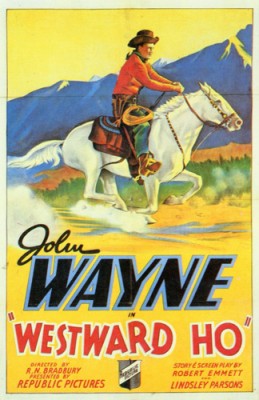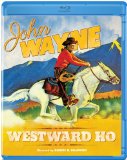| Reviews & Columns |
|
Reviews DVD TV on DVD Blu-ray 4K UHD International DVDs In Theaters Reviews by Studio Video Games Features Collector Series DVDs Easter Egg Database Interviews DVD Talk Radio Feature Articles Columns Anime Talk DVD Savant Horror DVDs The M.O.D. Squad Art House HD Talk Silent DVD
|
DVD Talk Forum |
|
|
| Resources |
|
DVD Price Search Customer Service #'s RCE Info Links |
|
Columns
|
|
|
Westward Ho
Wayne then made more than a dozen even cheaper "Lone Star" programmers for Monogram. Usually directed by Robert N. Bradbury and because of their public domain status now widely available - if not exactly viewable as their video transfers are beyond atrocious - most of these pictures co-starred stuntman-actor (and later second unit director) Yakima Canutt and character actors George Hayes and Paul Fix. These $12,500 features (of which Wayne received $1,250) are mostly terrible, but they were quite popular in the sticks and helped establish Wayne as a marquee name, plus they served as a great training ground for Wayne as an actor.*
Westward Ho (1935) was John Wayne's very first movie for the newly formed Republic Pictures, and it was the company's first, too. Republic was the studio with which Wayne was most associated until the mid-1950s, when they parted ways over Wayne's desire to make an epic about the Alamo and Republic's refusal to spend a lot of money on such a risky venture.
Westward Ho is a straight Western melodrama and a pretty good vehicle for Wayne, and compared to Wayne's Lone Star films it's positively lavish, having cost nearly double ($24,198) the average Lone Star picture. Like several of the Lone Star pictures, it does err in trying to fashion Wayne into a singing cowboy - the results are ludicrous - but otherwise it's a good film worth seeing.
And it's especially worth seeing because, despite its age, Olive Films has managed a flawless, dazzlingly pristine high-definition transfer.
In 1849, trail jumpers led by Ballard (Jack Curtis) and his chief henchman, Red (Yakima Canutt), murder cattle and freight drivers Mark and Hannah Wyatt (Hank Bell and Mary MacLaren). They kidnap their youngest boy, Jim (Dickie Jones), leave older brother John (Bradley Metcalfe) for dead and burn all their wagons.
By 1866, John Wyatt (here played by Wayne), now an adult, forms a vigilante group when underfunded government officials reluctantly decline his offer to wipe the territory clean of outlaws. (The first of the men he approaches, a blacksmith whose wife was murdered by outlaws never brought to justice, is played by Glenn Strange. Strange's hopeful-wistful expression upon receiving John's offer is rather touching, the kind of close-up Strange himself was rarely given.)
The vigilantes, known as "The Singing Riders" and who all ride white horses and wear black shirts with white kerchiefs, soon capture - but never lynch - a slew of outlaws, including Black Bart's gang. (This may be the only straight Western to have a Black Bart.)
John goes undercover, joining the Gordon herd as a trail boss, and where he becomes infatuated with Gordon's daughter, Mary (Shelia Bromley). Coincidentally, Ballard has dispatched John's brother, Jim (now played by Frank McGlynn, Jr.), to scope the cattle driven ahead of a planned ambush, with Jim now part of Ballard's gang yet completely unaware that John is his brother, or that Ballard murdered their parents.
Except for an outrageously silly sequence in which John serenades Mary, with Wayne's singing voice dubbed by a baritone who sounds like Sam the Eagle on The Muppet Show**, Westward Ho is fairly impressive. Instead of relying heavily on backlot Western streets, most of the film takes place on the plains of Lone Pine, California, a favorite location of William Boyd's Hopalong Cassidy films of the period, though much less frequently used by Republic.
Often these cheap films beefed up the number of cattle, stagecoaches, etc. through clever cutting and usually by incorporating older stock footage, but here the large number of horses, wagons, and men riding and driving them is impressively high. The stunt work is also terrific, though at the climax there's a disturbing crash where several horses appear to have been badly hurt. (This footage turns up in at least one other Republic film.)
The son of Frank McGlynn, Sr., who specialized in playing Abraham Lincoln (in at least a dozen films), Junior resembled the later character actor J.D. Cannon and is fine if a bit theatrical as Wayne's brother. He died just a few years after making this, at age 35, for reasons unknown to this writer.
Video & Audio
Olive Film's presentation of Westward Ho is effectively flawless. I found nothing at all wrong with this terrific high-def transfer, another great release with an absolutely pristine black-and-white, 1.37:1 image. The Region A disc has decent audio, English only with no subtitle options, and No Extra Features.
Parting Thoughts
A solid B-Western even non-fans of the genre might possibly like, and definitely worth seeing for its historical value and exquisite video transfer, Westward Ho is Highly Recommended.
* Sergei Hasenecz argues, "With due credit to Hayes and Fix, it is Canutt who makes this series more than ordinary. The stunts in these movies often surprise. You rightly point out that they are a training ground for Wayne. Of particular interest is what Wayne learns from Canutt in fighting, stunts, and especially demeanor. I think it is with the Lone Stars that Wayne begins to codify being John Wayne, and he himself credited Canutt for this. Watch them in series order and you will see the growth in Wayne. TCM runs very good prints of these, and it makes quite a difference in one's appreciation of them. Plus, as I noted for your review of The Lawless Nineties, Gabby got a lot of variety in the Duke's Lone Star westerns for Monogram, including playing villains in The Star Packer and Randy Rides Alone, both 1934, and both with Gabby in a double role. This latter is a favorite, with Gabby playing bad guy Marvin Black and his alter ego Matt the Mute."
** After he's done Mary exclaims, "Oh, please sing it again!" You can almost hear the audience shout "No!" at the screen en masse.
Stuart Galbraith IV is a Kyoto-based film historian whose work includes film history books, DVD and Blu-ray audio commentaries and special features. Visit Stuart's Cine Blogarama here.
|
| Popular Reviews |
| Sponsored Links |
|
|
| Sponsored Links |
|
|
| Release List | Reviews | Shop | Newsletter | Forum | DVD Giveaways | Blu-Ray | Advertise |
|
Copyright 2024 DVDTalk.com All Rights Reserved. Legal Info, Privacy Policy, Terms of Use,
Manage Preferences,
Your Privacy Choices | |||||||















